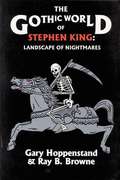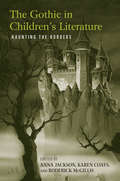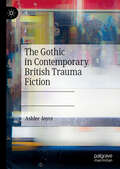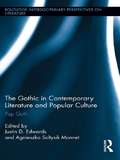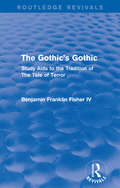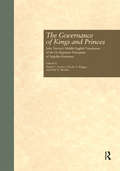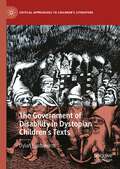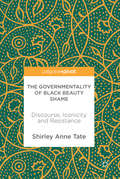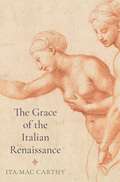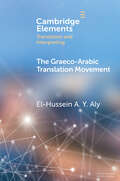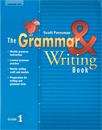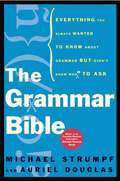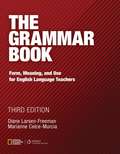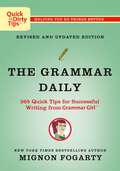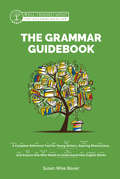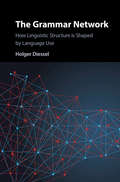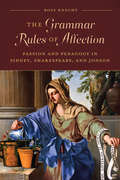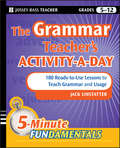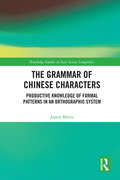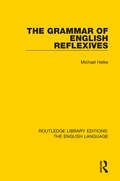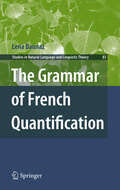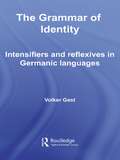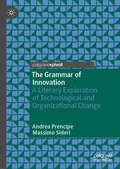- Table View
- List View
The Gothic World of Stephen King: Landscape of Nightmares
by Ray B. Browne Gary HoppenstandStephen King's popularity lies in his ability to reinterpret the standard Gothic tale in new and exciting ways. Through his eyes, the conventional becomes unconventional and wonderful. King thus creates his own Gothic world and then interprets it for us. This book analyzes King's interpretations and his mastery of popular literature. The essays discuss adolescent revolt, the artist as survivor, the vampire in popular literature, and much more.
The Gothic in Children's Literature: Haunting the Borders (Children's Literature and Culture #43)
by Karen Coats Anna Jackson Roderick McGillisFrom creepy picture books to Harry Potter, Lemony Snicket, the Spiderwick Chronicles, and countless vampire series for young adult readers, fear has become a dominant mode of entertainment for young readers. The last two decades have seen an enormous growth in the critical study of two very different genres, the Gothic and children’s literature. The Gothic, concerned with the perverse and the forbidden, with adult sexuality and religious or metaphysical doubts and heresies, seems to represent everything that children’s literature, as a genre, was designed to keep out. Indeed, this does seem to be very much the way that children’s literature was marketed in the late eighteenth century, at exactly the same time that the Gothic was really taking off, written by the same women novelists who were responsible for the promotion of a safe and segregated children’s literature. This collection examines the early intersection of the Gothic and children’s literature and the contemporary manifestations of the gothic impulse, revealing that Gothic elements can, in fact, be traced in children’s literature for as long as children have been reading.
The Gothic in Contemporary British Trauma Fiction
by Ashlee JoyceThis book examines the intersection of trauma and the Gothic in six contemporary British novels: Martin Amis’s London Fields, Margaret Drabble’s The Gates of Ivory, Ian McEwan’s Atonement, Pat Barker’s Regeneration and Double Vision, and Kazuo Ishiguro’s Never Let Me Go. In these works, the Gothic functions both as an expression of societal violence at the turn of the twenty-first century and as a response to the related crisis of representation brought about by the contemporary individual’s highly mediated and spectatorial relationship to this violence. By locating these six novels within the Gothic tradition, this work argues that each text, to borrow a term from Jacques Derrida, “participates” in the Gothic in ways that both uphold the paradigm of “unspeakability” that has come to dominate much trauma fiction, as well as push its boundaries to complicate how we think of the ethical relationship between witnessing and writing trauma.
The Gothic in Contemporary Literature and Popular Culture: Pop Goth (Routledge Interdisciplinary Perspectives on Literature)
by Justin D. Edwards Agnieszka Soltysik MonnetThis interdisciplinary collection brings together world leaders in Gothic Studies, offering dynamic new readings on popular Gothic cultural productions from the last decade. Topics covered include, but are not limited to: contemporary High Street Goth/ic fashion, Gothic performance and art festivals, Gothic popular fiction from Twilight to Shadow of the Wind, Goth/ic popular music, Goth/ic on TV and film, new trends like Steampunk, well-known icons Batman and Lady Gaga, and theorizations of popular Gothic monsters (from zombies and vampires to werewolves and ghosts) in an age of terror/ism.
The Gothic's Gothic (Routledge Revivals): Study Aids to the Tradition of The Tale of Terror
by Benjamin Franklin Fisher IVFirst published in 1988, this book aims to provide keys to the study of Gothicism in British and American literature. It gathers together much material that had not been cited in previous works of this kind and secondary works relevant to literary Gothicism — biographies, memoirs and graphic arts. Part one cites items pertaining to significant authors of Gothic works and part two consists of subject headings, offering information about broad topics that evolve from or that have been linked with Gothicism. Three indexes are also provided to expedite searches for the contents of the entries. This book will be of interest to students of literature.
The Governance of Kings and Princes: John Trevisa's Middle English Translation of the De Regimine Principum of Aegidius Romanus (Garland Medieval Texts #Vol. 19)
by Charles F. Briggs Paul G. Remley David C. FowlerFirst published in 1997. Routledge is an imprint of Taylor & Francis, an informa company.
The Government of Disability in Dystopian Children’s Texts (Critical Approaches to Children's Literature)
by Dylan HoldsworthThis book takes up the task of mapping discursive shifts in the representation of disability in dystopian youth texts across four historical periods where major social, cultural and political shifts were occurring in the lives of many disabled people. By focusing on dystopian texts, which the author argues act as sites for challenging or reinforcing dominant belief systems and ways of being, this study explores the potential of literature, film and television to act as a catalyst of change in the representation of disability. In addition, this work discusses the texts and technologies that continue to perpetuate questionable and often competing discourses on the subject.
The Governmentality of Black Beauty Shame
by Shirley Anne TateThis book uses the experiences and conversations of Black British women as a lens to examine the impact of discourses surrounding Black beauty shame. Black beauty shame exists within racialized societies which situate white beauty as iconic, and as a result produce Black ‘ugliness’ as a counterpoint. At the same time, Black Nationalist discourses present Black-white ‘mixed race’ women as bodies out of place within the Black community. In the examples analysed within the book, women disidentify from both the iconicities of white beauty and the discourses of Black Nationalist darker-skinned beauty, negating both ideals. This demonstration of Foucaldian counter-conduct can be read as a form of disalienation from the governmentality of Black beauty shame. This fascinating volume will be of interest to students and scholars of Black identity, Black beauty and discourse analysis.
The Grace of the Italian Renaissance
by Ita Mac CarthyHow grace shaped the Renaissance in Italy"Grace" emerges as a keyword in the culture and society of sixteenth-century Italy. The Grace of the Italian Renaissance explores how it conveys and connects the most pressing ethical, social and aesthetic concerns of an age concerned with the reactivation of ancient ideas in a changing world. The book reassesses artists such as Francesco del Cossa, Raphael and Michelangelo and explores anew writers like Castiglione, Ariosto, Tullia d'Aragona and Vittoria Colonna. It shows how these artists and writers put grace at the heart of their work.Grace, Ita Mac Carthy argues, came to be as contested as it was prized across a range of Renaissance Italian contexts. It characterised emerging styles in literature and the visual arts, shaped ideas about how best to behave at court and sparked controversy about social harmony and human salvation. For all these reasons, grace abounded in the Italian Renaissance, yet it remained hard to define. Mac Carthy explores what grace meant to theologians, artists, writers and philosophers, showing how it influenced their thinking about themselves, each other and the world.Ambitiously conceived and elegantly written, this book portrays grace not as a stable formula of expression but as a web of interventions in culture and society.
The Graeco-Arabic Translation Movement (Elements in Translation and Interpreting)
by El-Hussein A AlyTo encompass the history of Arabic practice of translation, this Element re-defines translation as combination, a process of meaning-remaking that synthesizes multi reality. The Arabic translators of the Middle Ages did not simply find an equivalent to the source text but combined its meaning with their own knowledge and experience. Thus, part of translating a text was to add new thought to it. It implies a complex process that Homi Bhabha calls “cultural hybridity,” in which the target text combines knowledge of the source text with knowledge from the target culture, and the source text is different from the target text “without assumed or imposed hierarchy.” Arabic translations were a cultural hybridity because the translators added new thought to their target texts, and because saw their language as equal to the Greek.
The Grammar Bible: Everything You Always Wanted to Know About Grammar but Didn't Know Whom to Ask
by Michael Strumpf Auriel Douglas“A readable grammar book that is hard to put down . . . this book is thorough, combining practical information not easily found in trade books.” —Library JournalNo one knows grammar like Michael Strumpf. For over a quarter of a century, as creator and proprietor of the National Grammar Hot Line, he helped thousands of callers from every corner of the globe tackle the thorniest issues of English grammar. Now, in The Grammar Bible, he has created an eminently useful guide to better speaking and writing.Unlike other grammar manuals, The Grammar Bible is driven by the actual questions Professor Strumpf encountered during his years of teaching and fielding phone calls from anxious writers, conscientious students, and perplexed editors, including such perennial quandaries as . . . Where do I put this comma?What case should this pronoun be in?How do I form the possessive of Dickens?Professor Strumpf explains these and other language issues with wit and wisdom, showing how to speak more clearly and write more impressively by avoiding common errors and following the principles of good grammar. Whether you need a comprehensive review of the subjunctive mood or simply want to know which form of a verb to use, The Grammar Bible is a practical guide that will enlighten, educate, and entertain.“Strumpf has been fielding calls on the National Grammar Hot Line for more than 25 years, telling callers how to make their subjects agree with their verbs and tell the difference between ‘who’ and ‘whom.’ Thus many of the examples in this thick but highly readable grammar handbook come from questions—sometimes rather charming ones—posed by callers.” —Publishers Weekly
The Grammar Book
by Diane Larsen-Freeman Marianne Celce-MurciaThe Grammar Book introduces teachers and future teachers to English grammatical constructions. This highly acclaimed text, used both as a course book and as a grammar reference guide, is suitable for all teachers of English. What sets it apart from other grammar books is its unique pedagogical focus: It describes not only how each grammatical construction is formed, but also its meaning and its use. Grammar is seen to be a resource for making meaning in textually and socially appropriate ways.
The Grammar Daily: Daily Tips For Successful Writing From Grammar Girl (Quick & Dirty Tips)
by Mignon FogartyAn updated edition of the classic tip-a-day grammar guide from New York Times bestselling author and creator of the Grammar Girl podcast, Mignon Fogarty.One hundred million podcast downloads say it all: Mignon Fogarty's kicky, practical, and easy-to-remember advice about style and usage has won her fans around the globe. Her first book, Grammar Girl's Quick and Dirty Tips for Better Writing, hit the New York Times bestseller list, and her weekly grammar podcast has been hailed by USA Today as "authoritative but warm."Here in tip-a-day form, Grammar Girl offers 365 lessons on language that are sure to inspire. Chock-full of bite-sized writing tips, fun quizzes, and efficient memory tricks, The Grammar Daily gives you the tools you need to improve your grammar and become an even better communicator, one day at a time.This revised edition of the book, previously published as The Grammar Devotional, has been updated throughout with new lessons and revised content to reflect shifting concerns in style and usage since initial publication.
The Grammar Guidebook: A Complete Reference Tool For Young Writers, Aspiring Rhetoricians, And Anyone Else Who Needs To Understand How English Works (Grammar for the Well-Trained Mind #0)
by Susan Wise BauerOn its own or as a supplement to the Grammar for the Well-Trained Mind program, this complete compendium of grammar rules and examples will become an indispensable guide to writing—throughout high school, into college, and beyond. With a new name, but the same, thorough, clearly-outlined rules of English Grammar, The Grammar Guidebook is the second edition to The Comprehensive Handbook of Rules. Originally designed to accompany the Grammar for the Well-Trained Mind program, this Grammar Guidebook stands on its own, assembling into one handy reference work all of the principles that govern the English language—from basic definitions (“A noun is the name of a person, place, thing, or idea”) through advanced sentence structure and analysis. Each rule is illustrated with examples drawn from great literature, along with classic and contemporary works of science, history, and mathematics. Grammar for the Well-Trained Mind is an innovative program that combines the three essential elements of language learning: understanding and memorizing rules (prescriptive teaching), repeated exposure to examples of how those rules are used (descriptive instruction), and practice using those rules in exercises and in writing (practical experience). Each year, parents and teachers go through the dialogue, rules, and examples in the Core Instructor Text; students follow along in the Student Workbook. This repetition solidifies the concepts, definitions, and examples in the student’s mind. There are four Student Workbooks, one for each year. Each Student Workbook contains the same rules and examples—but four completely different sets of exercises and assignments, allowing students to develop a wide-ranging knowledge of how the rules and examples are put to use in writing. Each Student Workbook comes with its own Key, providing not only answers, but also explanations for the parent/instructor, and guidance as to when the answers might be ambiguous (as, in English, they often are). All of the rules covered, along with the repeated examples for each, are assembled for ongoing reference in The Grammar Guidebook. Use Grammar for the Well-Trained Mind to teach English grammar thoroughly, effectively, and with confidence—no matter what your background or experience!
The Grammar Network: How Linguistic Structure Is Shaped by Language Use
by Holger DiesselCognitive linguists and psychologists have often argued that language is best understood as an association network; however while the network view of language has had a significant impact on the study of morphology and lexical semantics, it is only recently that researchers have taken an explicit network approach to the study of syntax. This innovative study presents a dynamic network model of grammar in which all aspects of linguistic structure, including core concepts of syntax (e.g. phrase structure, word classes, grammatical relations), are analyzed in terms of associative connections between different types of linguistic elements. These associations are shaped by domain-general learning processes that are operative in language use and sensitive to frequency of occurrence. Drawing on research from usage-based linguistics and cognitive psychology, the book provides an overview of frequency effects in grammar and analyzes these effects within the framework of a dynamic network model.
The Grammar Rules of Affection: Passion and Pedagogy in Sidney, Shakespeare, and Jonson
by Ross KnechtRenaissance writers habitually drew upon the idioms and images of the schoolroom in their depictions of emotional experience. Memorable instances of this tendency include the representation of love as a schoolroom exercise conducted under the disciplinary gaze of the mistress, melancholy as a process of gradual decline like the declension of the noun, and courtship as a practice in which the participants are arranged like the parts of speech in a sentence. The Grammar Rules of Affection explores this synthesis of the affective and the pedagogical in Renaissance literature, analysing examples from major texts by Philip Sidney, William Shakespeare, and Ben Jonson. Drawing on philosophical approaches to emotion, theories of social practice, and the history of education, this book argues that emotions appear in Renaissance literature as conventional, rule-guided practices rather than internal states. This claim represents a novel intervention in the historical study of emotion, departing from the standard approaches to emotions as either corporeal phenomena or mental states. Combining linguistic philosophy and theory of emotion, The Grammar Rules of Affection works to overcome this dualistic crux by locating emotion in the expressions and practices of everyday life.
The Grammar Teacher's Activity-a-Day: 180 Ready-to-Use Lessons to Teach Grammar and Usage
by Jack UmstatterQuick, daily classroom lessons for improving students' grammar and writing skills This must-have resource features 180 practical, ready-to-use grammar and usage lessons and activities-one for each day of the school year. The activities included help students in grades 5-12 to acquire, improve, and expand their grammar skills, and become more adept and confident writers. Veteran educator and best-selling author Jack Umstatter helps teachers to familiarize students with the type of grammar-related content found on standardized local, state, national, and college admissions tests. Includes ready-to-use, yet comprehensive and authoritative activities for use as sponge activities, extra homework, or regular daily lessons Reproducible lessons are designed to be non-intimidating and clear for students Other titles by Umstatter include Grammar Grabbers!, 201 Ready-to-Use Word Games for the English Classroom, Brain Games!, and Got Grammar? Tips for educators on how to best utilize each specific topic or lesson are included for easy classroom instruction.
The Grammar of Chinese Characters: Productive Knowledge of Formal Patterns in an Orthograhic System (Routledge Studies in East Asian Linguistics)
by James MyersAnybody who reads or writes Chinese characters knows that they obey a grammar of sorts: though numerous, they are built out of a much smaller set of constituents, often interpretable in meaning or pronunciation, that are themselves built out of an even smaller set of strokes. This book goes far beyond these basic facts to show that Chinese characters truly have a productive and psychologically real lexical grammar of the same sort seen in spoken and signed languages, with non-trivial analogs of morphology (the combination of potentially interpretable constituents), phonology (formal regularities without implications for interpretation), and phonetics (articulatory and perceptual constraints). Evidence comes from a wide variety of sources, from quantitative corpus analyses to experiments on character reading, writing, and learning. The grammatical approach helps capture how character constituents combine as they do, how strokes systematically vary in different environments, how character form evolved from ancient times to the modern simplified system, and how readers and writers are able to process or learn even entirely novel characters. This book not only provides tools for exploring the full richness of Chinese orthography, but also offers new ways of thinking about the most fundamental question in linguistic theory: what is grammar?
The Grammar of English Reflexives (Routledge Library Editions: The English Language #12)
by Michael HelkeThis work, first published in 1979, was a doctoral dissertation submitted to the Department of Foreign Literatures and Linguistics of the Massachusetts Institute of Technology in 1970. The first chapter of this thesis concerns the supposed complementarity of reflexives and ordinary anaphoric pronouns. In the second chapter a theory of reflexivisation is characterised which encompasses several other theories. The third chapter considers apparent counter-examples to the generalizations regarding reflexives that were established in Chapter Two. The fourth chapter concerns the meaning of reflexives. This book will be of interest of students of language and linguistics.
The Grammar of French Quantification
by Lena BaunazThis book is the first extensive study on French Quantification in the field of Syntax. It provides a typology of four main quantified noun phrases in French (existential, universal, negative and wh-), detailing their syntactic, semantic and prosodic behaviors and showing that they can be reduced to two classes--Split-DP structures or Floating quantification. Relying on syntax and semantics, the book establishes a three-way structural typology of wh in-situ phrases and extends it to existentials. It pays special attention to the prosodic properties associated with their different readings and proposes an analysis of the distribution of subextraction and pied-piping. Similarly based on semantic and syntactic tests, the book reveals N(egative) words to be universal Quantifiers. It proposes a new structure of N-words in terms of constituent negation and includes a detailed analysis of the difference between not an N and not all the N in French.
The Grammar of Hate: Morphosyntactic Features of Hateful, Aggressive, and Dehumanizing Discourse
by Natalia KnoblockHate speech continues to be an issue of key social significance, yet while its lexical and discursive aspects have been widely studied, its grammatical traits have been hitherto overlooked. This book seeks to address this gap by bringing together a global team of scholars to explore the morphosyntactic features of hateful and aggressive discourse. Drawing on thirteen diverse cross-linguistic case studies, it reveals how hate is expressed in political discourse, slang, and social media, and towards a range of target groups relating to gender, sexual orientation, and ethnic identity. Based on ideas from functional and cognitive linguistics, each thematic part demonstrates how features such as morphology, word formation, pronoun use, and syntactic structures are manipulated for the purpose of expressing hostility and hate. An innovative approach to an age-old problem, this book is essential reading for researchers and students of hate speech and verbal aggression.
The Grammar of Identity: Intensifiers and Reflexives in Germanic Languages (Routledge Studies in Germanic Linguistics)
by Volker GastEnglish self-forms and related words from other Germanic languages (e.g. Dutch zelf, Swedish själv, etc.) are used in two different functions: as ‘intensifiers’ (e.g. The president himself made the decision) and as markers of reflexivity (John criticized himself). On the basis of a comparative syntactic and semantic analysis, this book addresses the question of why two such apparently different functions can be expressed by the same word. This question is answered by showing that both intensifying and reflexive self-forms can be analysed as expressing the concept of ‘identity’. In the first part of The Grammar of Identity, the most central facts concerning the distribution of intensifiers in Germanic languages are surveyed and a detailed syntactic and semantic analysis is provided. It is shown that all instances of intensifiers can be analysed as expressions of an identity function. The second part of the book offers an analysis of reflexive self-forms which is based on recent theories of reflexivity, modifying these in some important respects. In particular, the distribution of reflexive self-forms is explained with reference to semantic properties of the sentential environment. In this way, it can be shown that reflexive self-forms – like intensifiers – can be analysed as expressions of an identity function. In addition to providing a thorough comparative description of the hitherto poorly described area of intensifiers in Germanic languages, this book offers an answer to a long standing question in descriptive and theoretical linguistics, namely why self-forms are used in two apparently different functions. By combining analytical methods from syntax, lexical semantics and sentence semantics the study moreover contributes to an understanding of the interaction between structure, meaning and context in a central area of lexico-grammar.
The Grammar of Innovation: A Literary Exploration of Technological and Organizational Change
by Andrea Prencipe Massimo SideriIn Six Memos for the Next Millennium, Italo Calvino elaborated on six concepts or memos to offer insights on the ‘shapes of things to come’, which were lightness, rapidity, exactness, visibility, multiplicity and consistency. To do so, the Italian writer embraced an interdisciplinary approach to describe each concept through juxtaposition of its antonyms, heaviness, slowness, indeterminacy, invisibility, uniqueness, and inconsistency. Inspired by Calvino’s intuition, this book puts forward the notion of the ‘Calvino Method’ to interpret the inner dynamics of innovation processes. Drawing on literature and cases from the fields of innovation, history of technology, organisation theory and corporate strategy, the book elaborates on each of the six concepts to offer a unique angle to understand innovation as technological, organisational and cultural change that generates value across a variety of domains. The linguistic juxtapositions at the root of the CalvinoMethod forms the framework of The Grammar of Innovation and the tension between opposites, which at first seems insoluble, emerges as the catalyst of future thought. This book will be of great interest to scholars of innovation, strategy, organisation studies, philosophy of business, and all those with an interest in the works of Italo Calvino.
The Grammar of Interactional Language
by Martina WiltschkoTraditional grammar and current theoretical approaches towards modelling grammatical knowledge ignore language in interaction: that is, words such as huh, eh, yup or yessssss. This groundbreaking book addresses this gap by providing the first in-depth overview of approaches towards interactional language across different frameworks and linguistic sub-disciplines. Based on the insights that emerge, a formal framework is developed to discover and compare language in interaction across different languages: the interactional spine hypothesis. Two case-studies are presented: confirmationals (such as eh and huh) and response markers (such as yes and no), both of which show evidence for systematic grammatical knowledge. Assuming that language in interaction is regulated by grammatical knowledge sheds new light on old questions concerning the relation between language and thought and the relation between language and communication. It is essential reading for anyone interested in the relation between language, cognition and social interaction.
